How to Grow and Use Achocha/Caigua (a Problem-Free Cucumber Substitute), with Recipes
Organic gardening often produces healthier, more easily grown vegetables and fruits than the same crops grown with “conventional” methods. There are, however, a few crops that have a pouty reputation for organic growers.
The cucurbit family claims most of these weak-kneed plants. I count on summer squash and cucumbers to be riddled with squash vine borer, cucumber worms, and fungal mildews by late summer. Though they offer prolific yields early on, I know I’ll be replacing them with sturdier crops around August.
That’s why I get so excited about possible substitutes for ornery plants! If I want to make tahini salad or pickle some cukes in September, I look to my disease-free row of achocha vines (Cyclanthera pedata).
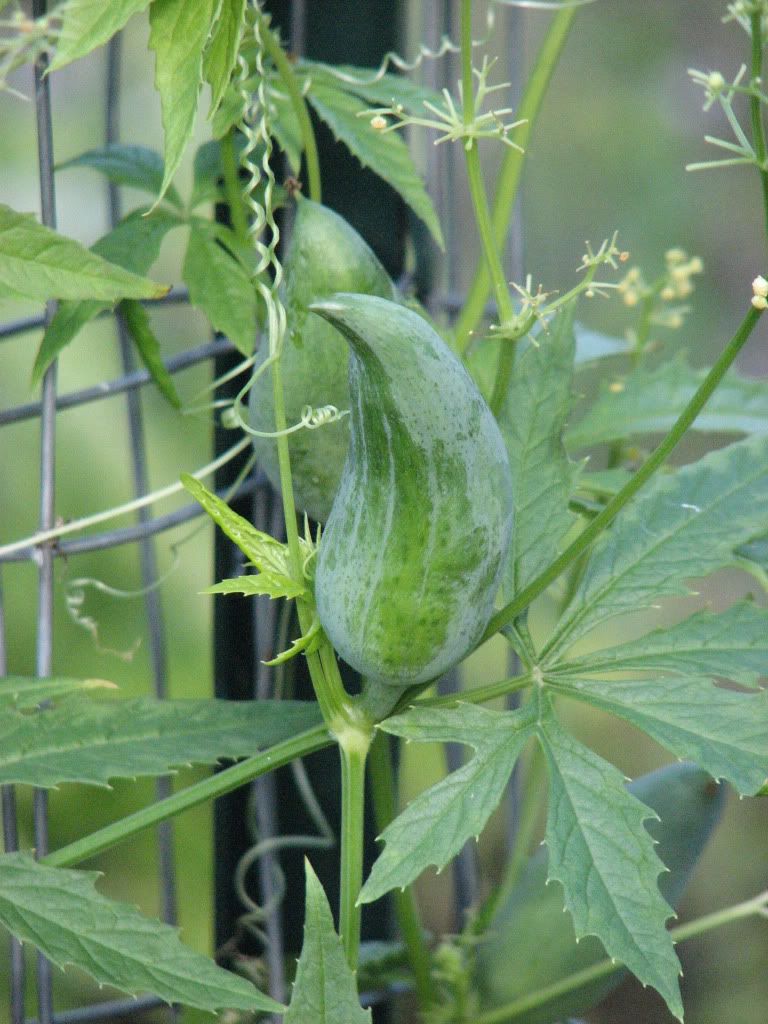
Photo Caption: Achocha is one of the easiest plants in my vegetable garden, with virtually no sign of diseases or pests all season long!
Cyclanthera pedata has a ridiculous pile of common names, so I’ll refer to it here by its Bolivian name of “achocha” (since that’s the name I bought it under). “Caigua” seems to be another of its most-used monikers.

Photo Caption: A perfect ornamental edible, achocha has dramatic foliage and beautiful slipper-shaped fruits.
Peru and Bolivia have a long history of using achocha in their local cuisine. There are as many ways to make traditional stuffed achochas as there are recipes for the “best” macaroni & cheese in the US. (In other words: infinite!) Because they were adapted in the various altitudes of the Andes, achochas seem to do well in the Appalachian region as well. They are heat tolerant (but need regular irrigation to prevent interrupted growth) as well as cold (but not frost) tolerant. A long growing season is required (90 – 110 days) for fruit production, which can be achieved at least as far north as New York.
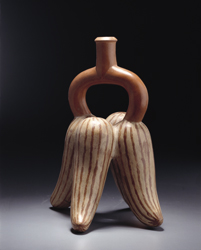
Photo Caption: Art from the Moche culture of Peru (around 100 AD to 800 AD). Achocha fruits were a common motif. Wikipedia Commons photo.
Achocha is old enough to appear in ancient art and has also been mentioned in the book Lost Crops of the Incas by the National Research Council. Despite its longevity in cultivation, it hasn’t lost its natural resistance to diseases and pests. This is one cucurbit that I’ll never call a “wimp!”
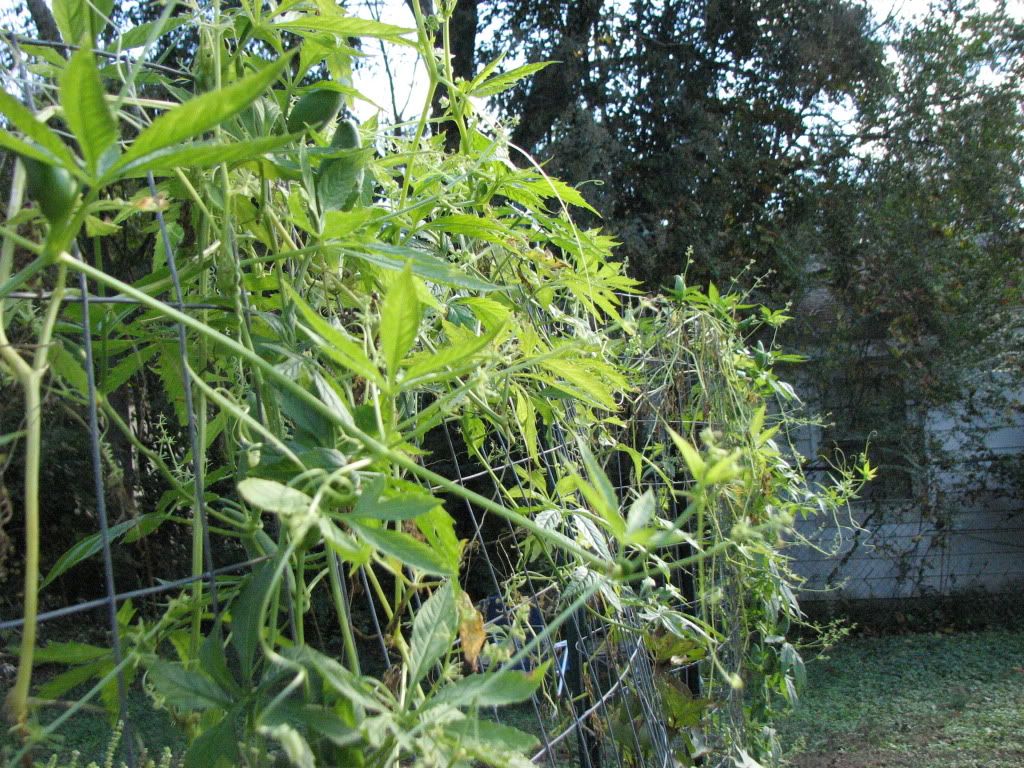
Photo Caption: Achocha will tolerate drought by resting until it receives more water. For constant growth, make sure achocha receives steady irrigation.
In fact, achocha vines deserve to be on the “must-grow” list for ornamental enthusiasts as well as edible gardeners. The vigorous, lightweight vines quickly cover any trellis or arbor with tropical-looking, palmate foliage. The beautiful leaves do look a bit familiar in shape — my friends couldn’t help teasing us about our crop’s similarity to an illegal species! Only two plants will coat a 12′ – 15′ long trellis in a single season. In temperate climates or a greenhouse they can achieve a height of 40′.

Photo Caption: Achocha's tiny flowers are popular with syrphid flies -- a family of beneficial pollinators which often eat aphids and thrips.
Though they do seem to be capable of self-pollination, best results are achieved with two or more plants. I saw plenty of beneficial syrphid flies visiting the tiny flowers in our garden. So adorable! I think they are one of my favorite insects.
Achocha starts producing in late summer and the young fruits are solid and crunchy. As they mature they begin to hollow out and form puzzle-piece shaped black seeds.

Photo Caption: The size of achocha fruit pictured here is mature enough to be hollow but small enough to taste tender when eaten raw.
Achocha can be harvested at any time while they are still green, though the young and older fruit have different culinary uses. Rumored to have health benefits such as reducing cholesterol, Wikipedia lists their nutritional info as follows:
“Peptin, galacturonic acid, dihydroxitriptamine, pierine, resins, minerals (phosphorus), vitamins (thiamine, vit. C), lipoproteins and steroidal compound (systosterol and 3 beta D glucoside) with hypoglicaemic and antilipemic (against cholesterol LDL) action, and low density lipoproteins.”

Photo Caption: These vines were so pretty and spotless in late fall that the photos make me think of spring growth.
I found them extremely easy to grow! If you start your own transplants, use the same timetable as tomatoes for your region. Otherwise, you can direct seed them into your garden beds after the danger of frost has passed. Early in the season your achocha vines will produce mostly leaves, so a foliage-based fertilizer used at the time of planting is best. Around July, apply a fertilizer balanced for fruit production.
When planting out, space them like you would winter squash or a vigorous cucumber (trellising is recommended). The vines aren’t as heavy as winter squash.
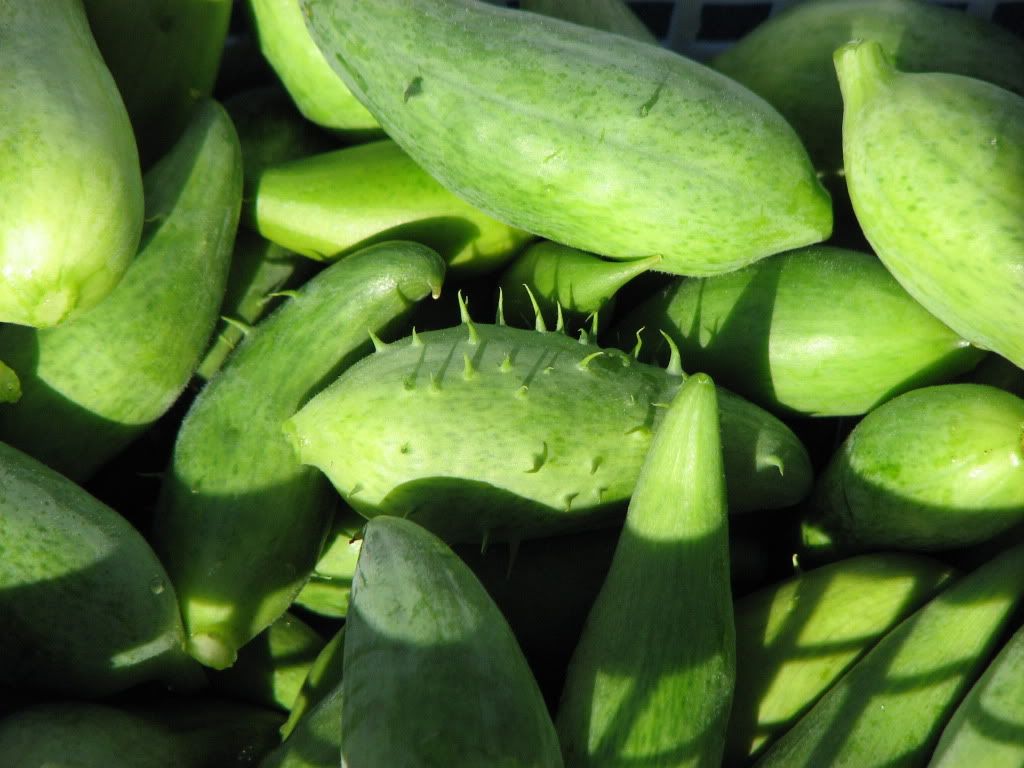
Photo Caption: Some of the fruits have more spines than others, but all of these spines are soft and completely edible.
Edible achocha (Cyclanthera pedata) are related to the novelty heirloom “exploding cucumbers” (Cyclanthera explodens syn. Cyclanthera brachystachya). Warning! — If you grow the exploding type, wear goggles when you harvest because the seeds can spray into your eyes! There is some internet confusion about which species the named achocha variety ‘Fat Baby’ falls under, but it appears to be most commonly listed as Cyclanthera brachystachya.
Like most fruiting vegetables, you should keep your achocha vines harvested (before the fruit matures past the green stage) so that they will stay productive. A well-maintained achocha plant will be prolific until frost. The odd black seeds are ripe before the fruit is past its prime, so saving seeds is as simple as setting them aside as you prepare your dinner. After that they need to be thoroughly dried (at room temperature) and stored in an airtight container.
Achocha won’t cross with your other cucurbits, so there is no need to separate it for seed saving.

Photo Caption: Nichol's Garden Nursery caught my eye with this photo of achocha -- it earned its space in the garden this year!
If you’d like to give this easy-going veggie a try, here’s a list of (global) sources:
- Nichol’s Garden Nursery (US)
- Long Island Seed Project, scroll to bottom of page (US)
- Amazon.com/Hirt’s Gardens (US)
- “Achocha” on Ebay (US)
- “Caigua” on Ebay (US)
- “Cyclanthera pedata” on Ebay (US)
- The Real Seed Catalogue, 3 varieties — scroll to bottom of page (UK/Europe)
- Heirloom Tomatoes Ltd. (England)
- Magic Garden Seeds (Germany/Worldwide)
Achocha shows its true cucurbit colors when it starts to flood your kitchen with little slipper-shaped fruits. Remind anyone of cousin zucchini? I like achocha fresh, but it also dehydrates, freezes, and cans well.
The immature fruits of achocha (before the black seeds mature) are delicious and most similar to standard cucumbers in taste and texture. As achocha matures it is still edible as a stuffing vegetable either raw or cooked, but cooking is recommended for tougher, aged fruits. Cooked achocha tastes less like cucumbers and more like a mixture of artichokes, beans, and green peppers.
Use young achocha raw on salads (although my daughter preferred to munch them right off the vine). They are commonly juiced in Peru and mix well with high-nutrient homemade juice recipes. Tender vine shoots (with leaves, flowers, and tendrils) are eaten raw, sauteed, or stir-fried. Mature achocha can be sliced onto pizza, mixed into curries, breaded and fried, or substituted in any recipe that calls for cooked green peppers. If you like the taste of Jalapeño poppers but can’t take the heat, achocha’s hollow shape is the perfect replacement.
Okra, green peppers, or cucumbers can be substituted in the below achocha recipes. I decided to adapt a favorite Greek yogurt & cuke recipe because it seemed ideal for a “stuffing” cucumber:
Achocha Stuffed with Greek Dilly Yogurt
- 2 cups Greek yogurt
- 6 or more mature achocha fruits, hollow but still green and tender, sliced in half & seeds removed
- 1/2 cup diced immature (solid) achocha fruits or regular cucumber
- 1 cup diced tomatoes, drained of excess fluid (optional)
- 1 garlic clove, minced (optional)
- 2 tbsp lemon juice
- 2 tbsp minced fresh dill (reserve a pinch for garnish)
- Combine the yogurt with the diced immature achocha (or cucumber), lemon juice, dill, and optional tomatoes and/or garlic. Stir gently until well mixed.
- Spoon the mixture into the center of the hollow, mature achocha halves.
- Garnish with reserved dill.
- Serve!
- Ajiaco de Caiguas (Caigua Ajiaco) @ Peru-Recipes.com
- Ajiaco de Papas (Potato Ajiaco) @ Peru-Recipes.com
- Caiguas Rellenas (Stuffed Caiguas) @ Peru-Recipes.com
- Caihua Rellena (Stuffed Caigua) @ Canela and Comino
- Fish-Stuffed Caigua @ The Global Gourmet
- Pepino Para Rellenar @ Palo Santo
- Achojcha Rellena – Bolivian Stuffed Caigua @ BoliviaBella.com
41 thoughts on “How to Grow and Use Achocha/Caigua (a Problem-Free Cucumber Substitute), with Recipes”
Comments are closed.

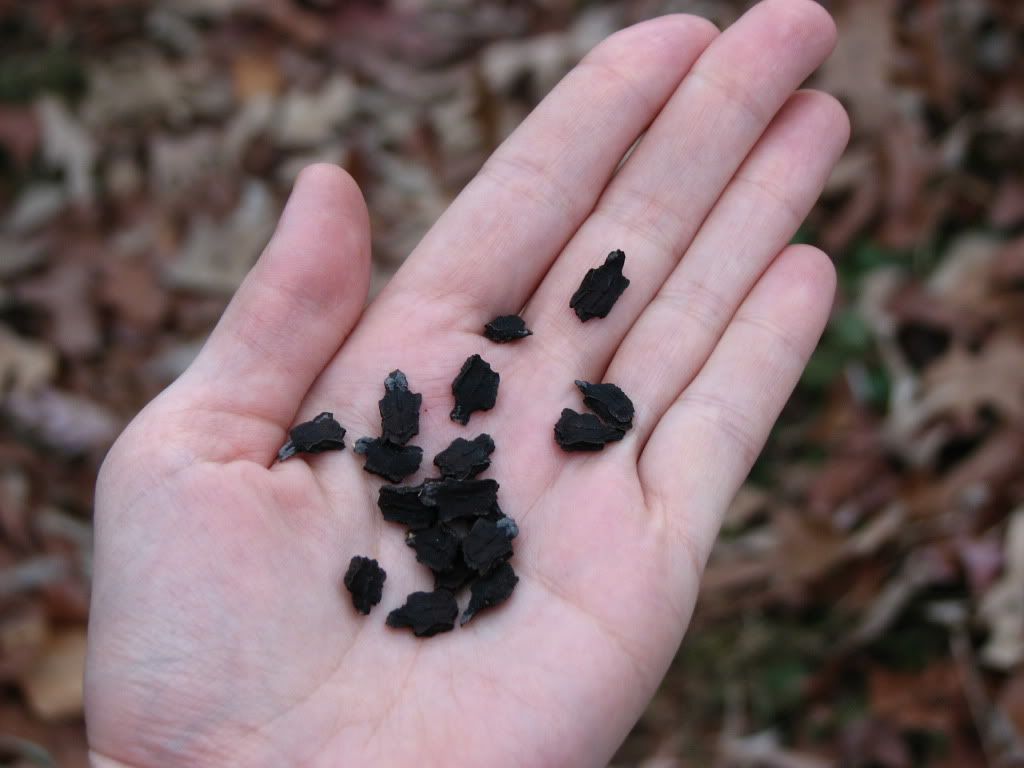

Carolyn @ Carolyn's Shade Gardens - December 13, 2010 4:33 pm
Very thorough and informative. I have never heard of this interesting vegetable. Carolyn
.-= Carolyn @ Carolyn’s Shade Gardens´s last blog ..Fall-blooming Camellias Part 1 =-.
tina - December 13, 2010 5:06 pm
Like Carolyn I’ve never heard of achocho before either. It sounds most interesting and those seeds are pretty cool. I’ll keep an eye out for it. It’s super good you posted sources too.
.-= tina´s last blog ..A Planting Diagram versus a Planting Design =-.
Janet - December 13, 2010 5:47 pm
Most interesting!!! So there some available around here? Worth checking into come spring. You need some Salad Burnet to add to your yogurt for that extra cuke boost.
.-= Janet´s last blog ..Frosty Herbs =-.
Sustainahillbilly
Twitter: appalachianfeet
- December 13, 2010 5:55 pm
Haha, I thought the same thing when I was reading your herbs post earlier! I grow it sometimes but don’t have any right now.
.-= Sustainahillbilly´s last blog ..How to Grow and Use Achocha-Caigua a Problem-Free Cucumber Substitute- with Recipes =-.
Elaine
Twitter: bucolicbushwick
- December 13, 2010 8:26 pm
Wow, very interesting! I never heard of this plant until I read your post, thanks for sharing
p3chandan - December 13, 2010 10:11 pm
Hi Eliza, interesting post for an unknown vegetable from the cucurbit family. Would love to try your recipe but I guess have to substitute with the Japanese cucumber Im growing.
.-= p3chandan´s last blog ..Pecah Kaca =-.
Sustainahillbilly
Twitter: appalachianfeet
- December 15, 2010 8:41 am
Japanese cucumber sounds like an excellent substitute! You could hollow some out for stuffing by removing the seed cavity with a spoon.
.-= Sustainahillbilly´s last blog ..How to Stop and Smell the Flowers 1 =-.
One - December 13, 2010 10:34 pm
This is new and interesting to me. Thanks for sharing.
.-= One´s last blog ..Environmental Speech =-.
Donna - December 13, 2010 11:06 pm
What an odd plant. I never heard of it, thanks for the info.
Andrea - December 13, 2010 11:49 pm
It is a very interesting cucurbits, yes the leaves look like as you said, the illegal species, but to me they look like the ampalaya or bitter gourd leaves (Momordica species). I wonder if it tastes like a bottle gourd or a cucumber! The list of nutrients is incredible. Thanks also for visiting my site.
.-= Andrea´s last blog ..Lets Think of Grass =-.
Sustainahillbilly
Twitter: appalachianfeet
- December 15, 2010 8:41 am
I wish I could tell you but I’ve never tried the bottle gourd (it does however, taste just like a cucumber when young).
.-= Sustainahillbilly´s last blog ..How to Stop and Smell the Flowers 1 =-.
Robin - December 14, 2010 7:51 am
Very interesting post. I have never heard of this vegetable before. I have to say that I finally had some time yesterday to look through your site….very good and a lot of helpful information.
.-= Robin´s last blog ..Making Homemade Mustard Update 1 =-.
lifeshighway
Twitter: lifeshighway
- December 14, 2010 10:21 am
Where I am not much of a gardener, I do love my veggies! This is a completely new plant to me. I will have to look for it because I am dying to try it. I am now on a hunt.
Although I suspect it is seasonal, but I will put it on my list of things to try.
Great, now I am craving something that I don’t even know what it tastes like.
.-= lifeshighway´s last blog ..Flamingo – A Florida Parasite =-.
Sustainahillbilly
Twitter: appalachianfeet
- December 15, 2010 8:42 am
Yeah you do, it totally tastes like cukes! You can grow it next to your shoe garden.
.-= Sustainahillbilly´s last blog ..How to Stop and Smell the Flowers 1 =-.
joey - December 14, 2010 12:45 pm
Love learning and this is totally new to me. Thank you for sharing!
Ellada - December 14, 2010 3:39 pm
Very interesting. I don’t know that vegetable. Thank you for sharing.
.-= Ellada´s last blog ..Les oiseaux Τα πουλιά The birds =-.
Carolflowerhill
Twitter: flora
- December 14, 2010 3:56 pm
Terrific post! I had never heard of this plant either. I love the shape of it. Regular cukes can really be difficult to grow. Thanks for the introduction to an alternative.
.-= Carolflowerhill´s last blog ..Seasonal Musings Moving South Part Two =-.
Sustainahillbilly
Twitter: appalachianfeet
- December 15, 2010 8:43 am
I definitely see how they got a “slipper” nickname — it reminds me of elves shoes or Dutch clogs.
.-= Sustainahillbilly´s last blog ..How to Stop and Smell the Flowers 1 =-.
debsgarden - December 14, 2010 5:01 pm
I’ve never heard of achocha! I would like to try one! Your post is very informative. I had to laugh when you mentioned achocha’s resemblance to a certain illegal species. This summer I had several seedling Japanese maples growing on my patio when a friend came to visit. She was horrified, and I’m not sure I managed to convince her my plants were baby trees!
.-= debsgarden´s last blog ..The End of Fall =-.
Sustainahillbilly
Twitter: appalachianfeet
- December 15, 2010 8:44 am
Haha! Yeah, I’ve had people think that about Japanese maples, and also about hibiscus (mainly the hardy varieties). Sometimes people even point at cleome with a funny look on their face!
.-= Sustainahillbilly´s last blog ..How to Stop and Smell the Flowers 1 =-.
Curbstone Valley Farm - December 14, 2010 5:10 pm
I must admit, this plant is new to me, but I think it would be great to try it. Excellent, and informative post Eliza. Any plant that’s attractive to Syrphid Flies is a good plant to have in the vegetable garden, and being edible and trouble-free is just an extra bonus!
.-= Curbstone Valley Farm´s last blog ..Project Inspire – 2010 =-.
Ali - December 14, 2010 6:43 pm
This is a great post Eliza, I had never heard of this vegetable either… and just to be cheeky I’d love to plant it out the front in plain view!
.-= Ali´s last blog ..26 Days of Planting- R is for Rhubarb =-.
Sustainahillbilly
Twitter: appalachianfeet
- December 15, 2010 8:45 am
Hah! Well let us know if any “authorities” come to check it out.
.-= Sustainahillbilly´s last blog ..How to Stop and Smell the Flowers 1 =-.
Ewa - December 16, 2010 5:20 am
Hello Eliza, what an interesting vegetable you present here – I’ve never heard of it before it’s great to learn new things every day.
it’s great to learn new things every day. ?
?
.
Eliza sounds like Polish name
.
Hugs,
.-= Ewa´s last blog ..China rose- December flowers – GBBD December 2010 =-.
LynnS - December 16, 2010 6:44 am
This is such an informative and exciting blog post! Naturally, I’m excited enough about Achocha to try growing it here in Virginia. Having a veggie with all edible parts is an added plus! Thanks for your links — my seed order is in!
Pingback: How to Find Great Plants #2 | Appalachian Feet
Nicole Kramer - March 5, 2011 1:21 pm
I’m growing achocha (lady slipper) from seed this year and my plants are out-growing my tomato seedlings by leaps and bounds! I need to get them outside asap as they’ve been growing about an inch every 3 days. So excited to try the fruit.
Pingback: How to Feel Inspired by an Urban Farm | Appalachian Feet
Paul Parkin - September 18, 2011 8:41 am
Just cropped a load of Achocha in Derbyshire England, wife is now making curries with the older ones. We grew them up a cane wig-wam (don’t do this with yours) use a large trellis about 8x6ft at our latitude. Vigourous growth, lots of fruit taste good raw in salads.
This is definately on the list for next year. Seeds from Heritage Seed Library (UK).
Sustainahillbilly
Twitter: appalachianfeet
- February 13, 2012 9:23 am
Thanks for the UK seed source!
Sustainahillbilly´s last blog post ..How to Prevent Fusarium Wilt on Tomatoes
Tad - May 11, 2012 9:15 pm
Next thing you know they’ll be designing an achocha-shaped building: http://en.wikipedia.org/wiki/30_St_Mary_Axe
and telling people of all of the hallucinogenic health benefits of just walking into the darn thing! I’m designing a permaculture playground for a Montessori school here in the banana belt of Southern Vermont, northern Appalachia that is, and this will make an exceptional cover for their new pergola. Thank you!
(Boy, 110 frost-free days, wouldn’t that be something …, sigh)
Tad´s last blog post ..Tad Montgomery & Associates
Diana - January 14, 2013 1:33 pm
Eliza,
I grew up eating caigua and it’s just delicious. so many ways to prepare it and i miss it so much.
where can i purchase seeds? we live in Maryland. if i plant early in the spring, like march, will i have mature caiguas by summer time?
Thanks so much!
Sustainahillbilly
Twitter: appalachianfeet
- January 16, 2013 9:53 am
Nichol’s Garden Nursery carries it:
Sustainahillbilly
Twitter: appalachianfeet
- January 16, 2013 9:53 am
Also, I don’t know how it will do in Maryland — you should let us know!
Diana - January 16, 2013 1:47 pm
Sure will. Thanks for the info!
Elsa - August 20, 2013 5:15 pm
Hi, I planted Caigua, early May, here in KS, The plant is all over and looking great! but there are not blooms. I have 3 plants total planted. Do you know when I will be able to see blooms? They just keep growing and growing but not blooms. Thanks for your help!
Diane Duffin - October 17, 2013 3:41 am
I have been growing Achocha for 5/6 years, a really lovely versatile veg/fruit to have in the garden. Needs quite a lot of trellis space to grow. I grow from my own saved seed, and this year I am going to the local gardening club and will be giving a lot of seed away to try and get people to grow them themselves.I live in Southern Ireland and so far have had no problems at all growing them here.Have had a bumper crop this year.It is now middle of October and they are still growing well!
JUNIE - November 6, 2013 11:56 am
Diane – I’ve been searching for achocha seeds for a very long time. I am eager to buy locally grown versus imported. I purchased seeds from John Kohler (growingyourgreens.com); he sent me 16 seeds for 3.00 but i was not successful last year. I’d like to try again in the spring. Will you sell me some seeds? I’d love to grow these curious-looking plant. I’ll be looking for your reply.
julie - February 14, 2014 2:47 am
I grew these for the first time this year, in my hot house , they have taken over. The fruit appeared and I thought..now what? This has given me some good ideas thanks
Liz - April 20, 2014 6:03 am
I’m so excited. I’ve just planted my first achocha seeds. Then i checked out this amazing post. Wow! They sound exactly what I need. I hope they grow well over here in Europe.
Liz´s last blog post ..Getting ready to launch Earth Day 2014!!
Pingback: Zucchini Cucumber Trellis Events Stillwater